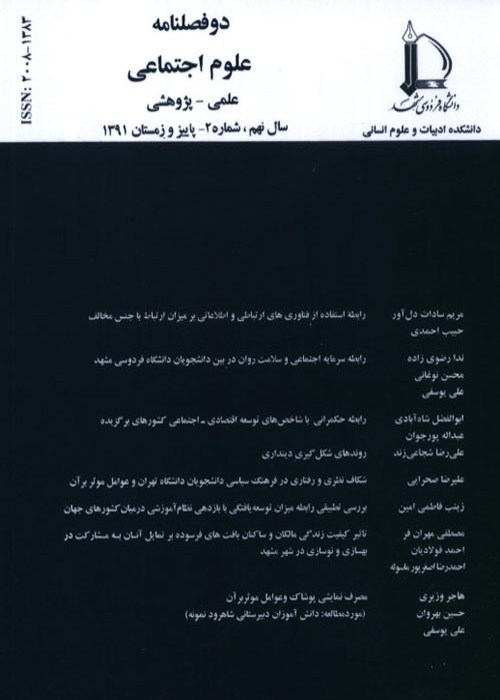The Translation and Validation of Social Capital Questionnaire for Adolescent Students (SCQ-AS)
Author(s):
Article Type:
Research/Original Article (دارای رتبه معتبر)
Abstract:
1.Introduction Social capital is one of the concepts that has attracted the attention of theorists of various research fields in the last two decades. Despite the increasing growth of social capital literature in various research fields, one of the most important challenges in this area is that the researchers are not paying attention to social capital studies for the adolescent generation and its effects on health. Most research in this area has studied social capital relations in the school environment and its effects on academic achievement and social adjustment. Among the most important shortcomings in this regard is the lack of appropriate scales along with precise measures for assessing social capital among the adolescent generation. Due to the lack of scales and tools for assessing social capital for the adolescent generation, the purpose of this study is to translate and determine the validity and reliability of Social Capital Questionnaire for Adolescent Students (SCQ-AS). In fact, Paiva et al. (2014) conducted its design, construction and validation for the adolescent students in Brazil. The main question of the present research is whether the Persian translation of the questionnaire has adequate validity and reliability for Iranian adolescent students. 2. Theoretical Framework
The study of theoretical approaches to social capital in the field of health indicates that social capital plays a key role in the health and well-being of individuals. By social capital in the field of health, we mean "the measures taken by the society in an effort to stimulate and mobilize policy makers to allocate resources for a specific purpose, such as the development of health promoting social infrastructures” (Abel, 2007, pp 51- 50). In this regard, Lin (2001) argues that social capital contributes to mental health. In his view, receiving approval and obtaining social credibility can lead to self-esteem in individuals in such a way as that protects the person from stress and maintains their balance, thereby enhancing the mental health and life satisfaction (Lin, 2001). From Putnam's point of view, there are four reasons why social capital and health are related: (1) Social networks offer financial help to peopleto reduce stress; 2) The networks reinforce health and health standards; 3) Better networks can ask for more suitable health services; (4) Evolution and social activities make the defense system of the body more active (Putnam, 2000). In general, theoretically, social capital can be to the benefit of the health of individuals in several ways: (a) Social capital contributes to a growing dissemination of information leading to health improvement (Kawachi & Berkman, 2000; McKenzie, 2006); b) In order to provide psychological support to individuals, social capital is able to create opportunities that tend to reduce stress and improve health (Kawachi & Berkman, 2001); (c) Social capital is often inclined toward more political organizations, which results in the allocation of more health resources for a region. Health resources further and improve access to health care and thus improve health (Kawachi & Berkman, 2000). 3.
Methodology
The research method in this paper was a cross-sectional survey. The statistical population consisted of all high school students in Saghez. At first, based on the cluster sampling, the relevant schools were selected and then, based on systematic random sampling, a sample size of 300 students (160 boys and 140 girls) was selected. The validity of the content of the questionnaire was determined through the experts' agreement, and its construct validity was determined through a confirmatory factor analysis based on structural equation modeling. The reliability and internal consistency of the questionnaire were also determined by Cronbach's alpha coefficient. The data were analyzed using SPSS v.19 software and LISREL 8.8 software.
4.Results
The results of this study show that internal coordination for each of the subscales as well as the overall scale of the situation is favorable. The validity and internal consistency of this questionnaire and the proximity of its results with the results of the main study (the total alpha coefficient calculated in the original study was 0.71%) suggest that the translation process of the present tool has been properly conducted and that it is of good comprehensibility. Hence, on the one hand, the respondents have not faced basic ambiguity when answering the questions. On the other hand, the items and factors of this scale have been insensitive to ethnic and cultural issues. This can be considered as a distinctive feature of the tool. The results of the confirmatory factor analysis based on the structural equation modeling (RMSEA = 0.038) is also consistent with the results of the study by Paiva et al. (2014), the four-factor structure of the questionnaire, including coherence in school, intimacy in school, social cohesion in the neighborhood, trust in school and neighborhood, was endorsed. As a result, none of the items in the survey questionnaire was deleted. In other words, there was a relationship between the content of the items from the point of view of the subjects and the factors related to each item.
5.Conclusion
In this paper, after translating and doing preparatory work with the aim of evaluating the validity and reliability of the Persian version among Iranian students, it became clear that the scale has the following benefits: 1) Concise, clear and short questions; 2) Emphasis on important and determining dimensions of social capital (such as coherence and intimacy in school, social cohesion in the neighborhood, and trust in the environment of schools and neighborhoods); and (3) The suitable adaptation of the questions in the questionnaire for Iranian adolescents and students. Its proper validity and reliability implies that this scale has the potential to become a practical guide for assessing the level of health among teenage students. Accordingly, the application of this scale is particularly important for conducting epidemiological studies, especially the studies on social capital and its effects on risk factors or health components among adolescent students. In order to overcome its shortcomings, it is suggested that the validity and reliability of this scale be examined in further studies by other researchers among wider samples in different parts of the country.Keywords:
Language:
Persian
Published:
Journal of Social Sciences, Volume:15 Issue: 1, 2018
Pages:
51 to 78
magiran.com/p1926123
دانلود و مطالعه متن این مقاله با یکی از روشهای زیر امکان پذیر است:
اشتراک شخصی
با عضویت و پرداخت آنلاین حق اشتراک یکساله به مبلغ 1,390,000ريال میتوانید 70 عنوان مطلب دانلود کنید!
اشتراک سازمانی
به کتابخانه دانشگاه یا محل کار خود پیشنهاد کنید تا اشتراک سازمانی این پایگاه را برای دسترسی نامحدود همه کاربران به متن مطالب تهیه نمایند!
توجه!
- حق عضویت دریافتی صرف حمایت از نشریات عضو و نگهداری، تکمیل و توسعه مگیران میشود.
- پرداخت حق اشتراک و دانلود مقالات اجازه بازنشر آن در سایر رسانههای چاپی و دیجیتال را به کاربر نمیدهد.
In order to view content subscription is required
Personal subscription
Subscribe magiran.com for 70 € euros via PayPal and download 70 articles during a year.
Organization subscription
Please contact us to subscribe your university or library for unlimited access!



